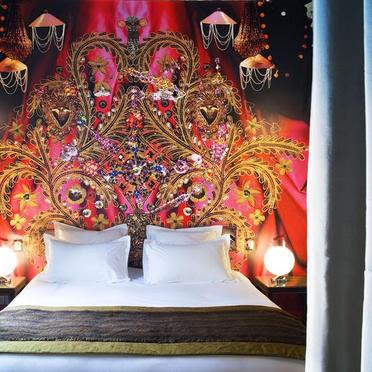
The last few lines from our scrawled directions was "keep the clock tower on your right... turn right into the mews... the second wooden gate on the left after a pair of pointed old-fashioned bollards, then up the cast iron stairs up to the front door lined with many flower pots..." And so we arrived at Jane Wildgoose's Memorial Library.
The charming door opened to reveal Jane herself, who ushered us in from the soggy weather outside and into her warm, inviting and quite frankly fascinating home. Minutes later we found ourselves in the library - Jane's studio and study - gas-fire glowing, gold and white tea set tinkling.
Behind me was this marvelous cabinet of curiosities (image below), glass doors open and inviting the visitor to engage their every sense, including touch. It is this in part that makes this a library and not a museum, as Jane believes that objects can be read and indeed carry a life of their own. She recalls her memories as a child by the seaside and, like many children, her instinct to peruse and collect from the offerings of the tide; this instinct to collect combined with her early experiences of old age and death as a child combined into a fascination and exploration of our treatment of death, life and all its rituals.

Each object and item is "... designed to facilitate meditation and free associations on subjects pertaining to the mysteries of the living in relation to the dead, transience, memory and immortality." The thoughtful placement of each object creates a visual language that allows us to consider the items within a greater subject; This talent for display is essential to the work as without their context certain pieces could be discarded as mundane or common, but within their frames they come alive with meaning.
Among the many items arrayed, I inspected Victorian locks of hair encased in glass-fronted lockets and rings, coiled and twisted to resemble feather plumes; I was part horrified, part comically delighted by a ridiculous armadillo handbag with little claws that encircled it's round body, the clasp a gleaming cyclops; Various glass boxes contained petrified animal remains, crumbling in their beds of velvet in their miniature coffins. Dried and decaying pomegranates also feature regularly throughout the display as the library is dedicated to the mythic Queen of the Underworld, Persephone.
There is a striking sense of peace in the library, a calmness and sense of belonging conveyed through the warm presence of Jane. She provides a dedicated space for reflection without the implications or specific rituals of religion. Her patience and eagerness to share her work and discoveries over steaming cups of tea is infectious, and we left the Wildgoose Memorial Library brimming with enthusiasm and small awakenings. Thank you Jane for a truly inspiring day.


Inspired by our afternoon at the library, I did a little image search for 'cabinet of curiosities'. Taxidermy, shells, coral, fossils, minerals and other petrified life-forms are popular themes, as are anatomical anomalies and wonders. The strange, the unusual, the ugly and the beautiful are all welcome here in our efforts to understand ourselves and the world in which we find ourselves, or indeed simply to appreciate them for their aesthetic and individual properties.

The Artist in his Museum, Charles Willson Peale (self-portrait), 1822.

The partially lost collection or Georg Gasser (1857 - 1931), an artist and painter who collected 2000 mineral specimens, 5000 petrefacts, 2000 shells, and various animals and skeletons of all kinds. The remains of his collection have formed a new museum in Bozen.
Teylers Museum, Haarlem, The Netherlands.
Cabinet of Curiosities, Unknown, late 17th century,
oil on canvas, Florence, Opficio delle Pietre Dure.

A medical book from the marvelous blog Morbid Anatomy at blogspot.
Cabinet of Curiosities, second half of the 17th C., Dommuseum du Salzburg, Austria.

Ole Worm, Museum Wormianum, Leiden, 1655. Illustration of a 17th century cabinet of curiosities.

And with that, I close the curtain upon this particular cabinet and I hope it contained some inspiring wonders. Thank you for reading...
























































